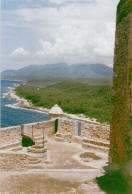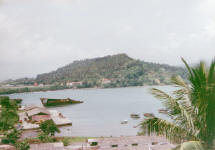Travels in Cuba (part 2 of 3)
From Santiago to Bacanoa National Park to Baracoa
Santiago is the carnival capital of Cuba and we timed our visit to coincide with the annual Festival in the city that runs during the last week of July with the biggest celebrations on the 26th of July, one of Cuba's most important feast days. Full roasted pigs are sliced and sold in sandwiches on the market stalls. Music and singing flow from the open doorways and the dancing is wild and flamboyant. The Cubans know how to party. The city was packed due to the Festival and to get accommodation in the centre of the Parte Vieja you would need to book well in advance. We stayed out in the suburbs, actually in one of the wealthier parts, which was a definite change from our other locations. We stayed near the Zona Especial. It's called a special zone because Castro and other Government officials have houses there.
 Very colonial looking and full of Palm trees,
it is Santiago's answer to Beverly
Hills, however all the houses are in need of a fresh coat of paint. We met a very
nice couple, Pepe and Claudia, through our landlady and ate in their house every
night. The food was delicious and he was eager to talk about the realities of Cuban
life. He explained that although trained as an engineer, he makes more money from
his job making and selling shark teeth necklaces and coral jewellery to the tourists
in the Gran Parque Natural Bacanoa, than when he worked as an engineer. His father
was Spanish so he has both Cuban and Spanish nationality. This allows him to travel
outside Cuba a privilege not many, even his wife, are granted. At the time he was
trying to get papers together to allow his wife and daughter travel out of the country
with him, but it's difficult. Pepe's house was bought by his father in 1930 when
he arrived from Spain, he now lives there with his wife, daughter, son-in-law and
granddaughter. He owns the house but cannot sell it. If he wants to move he would
have to get permission from the Government who will probably want to take his house
as it is in this special zone and give him a house somewhere else.
Very colonial looking and full of Palm trees,
it is Santiago's answer to Beverly
Hills, however all the houses are in need of a fresh coat of paint. We met a very
nice couple, Pepe and Claudia, through our landlady and ate in their house every
night. The food was delicious and he was eager to talk about the realities of Cuban
life. He explained that although trained as an engineer, he makes more money from
his job making and selling shark teeth necklaces and coral jewellery to the tourists
in the Gran Parque Natural Bacanoa, than when he worked as an engineer. His father
was Spanish so he has both Cuban and Spanish nationality. This allows him to travel
outside Cuba a privilege not many, even his wife, are granted. At the time he was
trying to get papers together to allow his wife and daughter travel out of the country
with him, but it's difficult. Pepe's house was bought by his father in 1930 when
he arrived from Spain, he now lives there with his wife, daughter, son-in-law and
granddaughter. He owns the house but cannot sell it. If he wants to move he would
have to get permission from the Government who will probably want to take his house
as it is in this special zone and give him a house somewhere else.
Santiago for me wasn't as picturesque as Trinidad nor as cosmopolitan as Havana but it has it's own delights especially during carnival. The carnival parades are elaborate and colourful, filling the streets with the passion of the city. Cuba at any time of the year is full of music but to be there during "Carnavale" magnifies the experience twenty fold. The centre of the city is lovely and contains the oldest building in Cuba, Diego Vel?quez's house built in 1512. There's an interesting museum - Museo Emilio Bacard?Moreau containing artefacts from the Revolutions and a lovely art collection upstairs. The musical epicentre of the town, the Casa de la Trova, is also worth a visit although sometimes they use it to give a chance to lesser-known singers during the day and they are often not of the highest calibre. Outside the city is the famous El Morro fortress (see photo above). Used to protect Cuba from the invading Spanish in 1898 and also as a prison during Castro's early years it's very impressive and the views from it of the coastline are spectacular. The church of the Virgin de la Caridad, the patron saint of Cuba, is worth visiting to see the adoration the Cubans have for her. The church was packed with floral offerings and mementoes. The final resting-place of Jose Mart?in Cementario Santa Ifigneia is also worth a visit. On our journey around Santiago to see the many sights we came back into the city through the back streets. The poverty here is tangible. The houses were more dilapidated than any we had seen and there were queues outside the government stores with people trying to get food. Anywhere else this would be the area that tourists would avoid yet we drove through in our air-conditioned Mercedes taxi unhindered.
 On the Eastern tip of Cuba is Baracoa. It's probably the most typically Caribbean
place on the Island. The journey to it is breathtaking and not just for the scenery,
the road is literally cut into the mountain and sometimes it's actually scary looking
out of the windows. We drove there in the morning and there was early dew on the
grass. The vegetation is lush and green, full of palm and coconut trees and banana
plants. In Baracoa we saw a traditional celebration of a fifteen-year old girl's
birthday. It's as big as a wedding. Balloon-covered cars drive along beeping horns
and stop to take photos of the lucky girl in front of the village monuments. Unfortunately
we only had 2 days in Baracoa. We took one of these to climb up and explore the
base camp of the mountain La Yunque. The houses on the mountain are mostly little
huts with straw roofs. The journey up to the base camp is about 5km. The norm is
to cycle and then hike. However we were very tired from all the travelling and opted
to take a taxi and then walk. This was definitely the smarter option as the road
was full of potholes. It would have been a nightmare on a bike. If you think the
roads in Ireland are bad, they are nothing compared to this.
On the Eastern tip of Cuba is Baracoa. It's probably the most typically Caribbean
place on the Island. The journey to it is breathtaking and not just for the scenery,
the road is literally cut into the mountain and sometimes it's actually scary looking
out of the windows. We drove there in the morning and there was early dew on the
grass. The vegetation is lush and green, full of palm and coconut trees and banana
plants. In Baracoa we saw a traditional celebration of a fifteen-year old girl's
birthday. It's as big as a wedding. Balloon-covered cars drive along beeping horns
and stop to take photos of the lucky girl in front of the village monuments. Unfortunately
we only had 2 days in Baracoa. We took one of these to climb up and explore the
base camp of the mountain La Yunque. The houses on the mountain are mostly little
huts with straw roofs. The journey up to the base camp is about 5km. The norm is
to cycle and then hike. However we were very tired from all the travelling and opted
to take a taxi and then walk. This was definitely the smarter option as the road
was full of potholes. It would have been a nightmare on a bike. If you think the
roads in Ireland are bad, they are nothing compared to this.
It was very educational with our guide Rav?pointing out the differences between palm and coconut trees, apparently the palm trees have a spike sticking out of them at the top. We stopped on our way up the mountain for coffee, fresh coconut milk, pineapples and bananas plucked from the trees, the pineapples were the juiciest I had ever tasted. The people on the mountain are self sufficient except for rice and sugar, which they need from the village. The old men cook stew in big pots on open fires and sit around smoking cigars and talking. Further up the mountain we swam across a fast flowing river, climbed up rocks to swim under a waterfall. It was amazing. This is the side of Cuba you are not going to find in tourist resorts. Talking to Rav?was informative, he told us that by taking us on that trip he was breaking the law, as it is illegal for people to work for themselves. Rav?said that the police sometimes look the other way. He also deals in second-hand clothes and with a few friends organises the redecoration of houses convincing families that it will make them more appealing to tourists. That's the root of it all again, everyone needs dollars and tourists have them. It's sad to see someone as resourceful as Rav?not being able to work to his full potential. In somewhere like the US he would probably make a fortune, from the very thing he is persecuted for in Cuba. During one of our nights in Baracoa we visited El Rancho, a hilltop disco overlooking the village. The music was far removed from the traditional salsa and son music heard in all the Casa de la Musicas. It was sweaty and packed like a night-club back home and though it might not be for everyone, we enjoyed an alternative look at Cuban entertainment.
>> Continue with part 3
<< Go back to part 1
